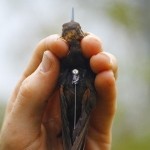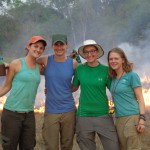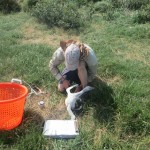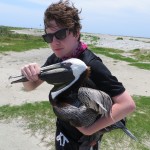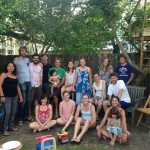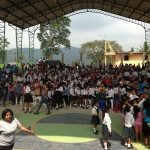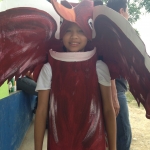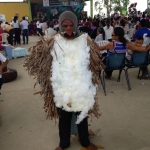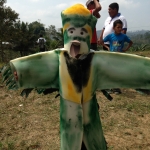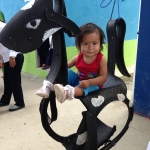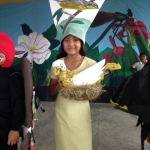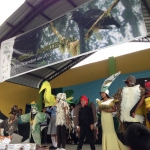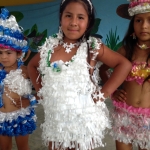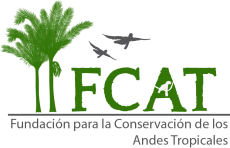Fall 2014
Autumn is here, and most lab members have returned from the far ends of the earth to New Orleans for fall semester at Tulane. It was quite the summer, and things show little sign of slowing down in the fall. Since the last update, we received a grant from the National Science Foundation for work on white-shouldered fairy-wrens in Papua New Guinea, and had publications come out in Evolution, Canadian Journal of Zoology, and Journal of Tropical Ecology.
Luke Browne was in Ecuador, collecting data on palm dispersal and demography at Bilsa Biological Station and mentoring research by Malinda Chambers, now a +1 MS student in the lab, and John Bailey Cox, a Tulane undergrad. Luke is remaining down in Ecuador through the end of the year to study forest fragments, as described below.
Brock Geary worked with Dr. Scott Walter to successfully deploy 14 GPS tracking devices on brown pelicans in the Gulf of Mexico, with support from the National Geographic Society. He is now working through the trove of data he collected. Brock has been developing a collaboration to link pelican movements to distributions of the fish they forage upon with Dr. Kevin Purcell, a new friend of the lab!
Erik Enbody conducted research on white-shouldered fairy-wrens at our study site in Papua New Guinea’s Milne Bay Province, and gathered additional data from Western, and Enga Provinces. With support from the Disney Worldwide Conservation Fund, he and Max Alliaga to helped to produce a short film on this project and worked with resident Serena Ketaloya to provide a series of training workshops and educational events for local communities.
Zoe Diaz-Martin spent time in Ecuador becoming familiar with the field site, helping Luke, and also collecting seed trap data with local resident researcher Domingo Cabrera. Zoe is now busy taking classes and settling into life in New Orleans.
After wrangling pelicans over the summer, post-doc Dr. Scott Walter is currently in Ecuador, working with Luke and our friends at FCAT. They are leading a research team consisting of local residents, university students, and PhD level researchers. The team is assessing effects of forest fragmentation on biodiversity, with focused studies of many taxa including amphibians, mammals, understory bird communities, nocturnal birds, beetles, orchid bees, bird parasites, soil bacteria, palm species diversity, and forest structure. This project is supported by US Fish & Wildlife Service, Disney Worldwide Conservation Fund, CREOi, and Conservation, Food & Health Foundation.
Over the summer, Jordan Karubian caught up with Sam and the IRES team in Australia, and then visited Erik in Papua New Guinea. He traveled to the Animal Behavior Society meeting in August, as well as the American Ornithologists Union annual meeting in September, where he presented along with Sam, Erik and Brock. Jordan and friend of the lab Renata Ribeiro are currently seeking students for Tropical Field Biology and Conservation (EBIO 378), a summer field course in Ecuador! Stay tuned for our next update, in early 2015.
Read MoreSpring 2014
Spring semester has come to an end, and the Lab is preparing to scatter to the far corners of the globe for research and conservation activities! Lots of exciting news from these past few months, and lots of good things to look forward to.
Brock and Scott are already in the midst of field work with Brown Pelicans on the Gulf Coast, deploying GPS tracking units, and researching chick survival. Brock received a SeaGrant to bring on undergrad Lily Armstrong-Davies as a field assistant.
Jenny received a grant from the Animal Behavior Society to continue work on nectar robbery and hummingbird pollination this summer. She’ll be heading out to the field mid to late summer to Peru, radio telemetry equipment in hand!
Erik is preparing for three months in Papua New Guinea to study White-shouldered Fairy Wrens, funded in part with a grant he won from the American Ornithologists Union. He will be returning to the existing field site in Milne Bay, and Jordan will join him for a couple of weeks of galavanting through PNG’s little-known Western Province.
Sam advanced to PhD candidacy, and recently got back from a trip to WSU doing hormone analysis with the Schwabl lab. She and Tulane students Nicole Moody, Alex Gulachenski, and Roxy Franta are gearing up to head down under for the summer for the third year of our NSF-funded IRES project in Australia. Congrats to both Nicole and Alex for receiving Newcomb grants to supplement the summer research!
The Karubian and Derryberry labs teamed up on outreach by doing a workshop with middle school girls as part of the Tulane Girls in Science and Technology program (GIST) and by volunteering with kindergarteners from Kipp NOLA primary.
Luke also advanced to PhD candidacy this past Spring! He’s leaving soon for a 6 month field excursion to Ecuador where he will continue his work on pollen and seed dispersal of Oenocarpus. He will be joined in the field by Tulane undergrads Malinda Chambers and John Bailey Cox, who were awarded Newcomb and Taylor grants, respectively. A few of some videos from last summer were featured on a nature documentary website here and here.
The lab also received new grants from the Conservation, Food and Health Foundation and Tulane’s Center for Latin American Studies for work on fragments in Ecuador, and produced one new publication on patterns of amphibian diversity in Ecuador (Jongsma et. al 2014)
Nathan Frumkin successfully completed his honors thesis on Northern Mockingbirds, and was awarded the Cagle Prize and the Honors Scholar Prize. We are thrilled that Nathan will be remaining in the lab next year for a 4 + 1 Masters, to continue work on mockingbirds. With collaborators Renata Duraes Ribeiro and Elizabeth Derryberry, the lab received a grant from the Morris Animal Foundation to study how Northern Mockingbirds in New Orleans may be impacted by environmental lead.
We are happy to welcome incoming PhD student Zoe Diaz-Martinez into the lab! She will be starting in the fall semester and will be working on the seed dispersal project in Ecuador.
Jordan is looking forward to spending some Q.T. with the fairy-wrens this summer. He will be visiting Sam and the IRES crew in Australia’s Northern Territory before dropping in on Erik in Papua New Guinea. He will be back in the US in time to attend the Animal Behavior Society meeting in August.
Last but definitely not least, a hearty congratulations to our collaborator and friend Monica Gonzalez, Director of FCAT, for winning the prestigious Whitley Prize for her conservation work in Ecuador. Be sure to check out the short film on her work narrated by Sir David Attenborough – congratulations Monica!
Read MoreWinter 2013 – 14
It’s been a busy winter break and start of the semester for the Karubian lab! First off, we’d like to welcome Roxanne Franta (4+1 MS student) and this year’s NSF IRES fellows Alex Gulachenski and Nicole Moody to the lab.
In December, Jordan took a trip to Ecuador to attend FCAT’s second annual Environmental Fair in La Y de la laguna, in the Mache-Chindul Reserve. With the theme of ‘Migratory Bird Conservation’, the fair included poetry competitions, a migratory bird costume exhibition, and gowns made of recycled material. The event was attended by over 1200 local residents. Here are a few pictures from the event:
Though it’s only January, the Karubian lab has already started preparing for upcoming field seasons. Jenny has been applying to grants to fund her field season in Peru this summer, while simultaneously working up a manuscript on nectar production and hummingbird pollination of an Andean plant species and refining her lobster costume for Mardi Gras! Brock and Scott are eagerly awaiting the arrival new batch of GPS transmitters to track Brown Pelican movement this year, while continuing work on analyzing the population genetic structure of Brown Pelicans on the Gulf Coast. Luke is planning on defending his prospectus this spring and head off to Ecuador for field work this summer.
Sam has spent the winter break in Australia continuing field work on Red-backed Fairy-wrens, where they are finally breeding. Erik has recently finished genotyping White-shouldered Fairy-wrens captured from his work during the summer of 2013 in Papua New Guinea. He is working on setting up a new field site for 2014 and is looking for assistants to join him in the field. See the following link for more info: Field assistants in Papua New Guinea.
On the publishing front, check out some recent articles from the Karubian lab:
2014
Karubian, J. and R. Durães. Impacts of mating behavior on plant-animal seed dispersal mutualisms: a case study from a Neotropical lek-breeding bird. In Sexual Selection: Insights from the Neotropics (eds. R. Macedo and G. Machado). Elsivier Press. Pp. 365-390. PDF
2013
Carrasco, L., Berg, K. S., Litz, J., Cook, A. and J. Karubian. 2013. Avifauna of the Mache-Chindul Reserve, northwest Ecuador. Neotropical Ornithology 24: 331-324. PDF | Appendix
2013
Walter, S.T., M.R. Carloss, T.J. Hess, G. Athrey, and P.L. Leberg. 2013. Brown Pelican movement patterns and population structure. Condor 115:788-799. PDF
2013
Walter, S.T., M.R. Carloss, T.J. Hess, and P.L. Leberg. 2013. Hurricane, habitat degradation, and land loss effects on Brown Pelican nesting colonies. Journal of Coastal Research 29:187-195. PDF
Read MoreFall 2013
Welcome to the newly redesigned Karubian lab webpage! Special thanks to Jess Henkel of Caz Taylor’s lab and Thomas Cheek for helping getting it set up, and Murray Cooper for letting us use his amazing photos.
Lots of news to catch up on…
First off, check out these latest publications out of the Karubian lab: Effects of forest disturbance and habitat loss on avian communities in a Neotropical biodiversity hotspot by Durães et al. (PDF) in Biological Conservation and Female ornamentation in Malurus fairy-wrens: a hidden evolutionary gem for understanding female perspectives on social and sexual selection (PDF) by Jordan Karubian in Emu.
This August marked the inaugural offering of EBIO 466: Tropical Field Biology and Conservation, an intensive two week field course in Ecuador for Tulane undergraduates. The class was led by Jordan Karubian and Renata Durães with Luke Browne as the teaching assistant. Read news coverage of the course here and here and read more about the class on the Courses page.
Karubian et al.’s paper Mating behavior drives seed dispersal in the long-wattled umbrellabird Cephalopterus penduliger (PDF) won the 2013 Biotropica Award for Excellence in Tropical Biology and Conservation. Congratulations!
Jordan and collaborators received grants from the Disney Worldwide Conservation Fund for community-based research partnerships in Ecuador and Papau New Guinea. Jordan also gave presentations at the University of Maine for the Sustainable Solutions Initiative, and here locally to the New Orleans Audubon Society at the Five Happiness Chinese Restaurant.
Scott has been awarded a grant from the National Geographic Society to research the effects of hypoxia and prey distribution on Brown Pelican foraging ecology and demographic processes. This funding will allow us to continue our fine-scale tracking of pelicans in the northern Gulf of Mexico via GPS tracking units.
Read MoreJune 2013
Summer is in full swing, and the lab is scattered far and wide. Jenny is in Peru working on her hummingbirds and flowerpiercers. Luke Browne is in Ecuador conducting seed dispersal research in Bilsa Biological Station. Sam Lantz is in Australia working with red-backed fairy-wrens and coordinating our International Research Experience for Students (IRES) project. Erik Enbody has spent time in Australia with Sam learning the ropes and is now in Papua New Guinea working with white-shouldered fairy-wrens. Scott is in Europe advancing his interdisciplinary research. Closer to home, Brock Geary has been working on brown pelicans and other seabirds nesting on Gulf of Mexico barrier islands. Jordan and family have returned from a semester in Brazil, and are gearing up for their first Tropical Biology field course to Ecuador, in August.
This has been a productive few months for the lab. We received a grant from the USFWS ‘Neotropical Migratory Bird Conservation Act’ program for continued work in Ecuador, and a number of smaller research grants and fellowships. We also had two publications come out, one on flamingo aggression in Zoo Biology (headed up by Mitch Hinton and Anne Bendelow, two Tulane undergraduates) and one on red-backed fairy-wren geographic variation in BMC Evolutionary Ecology, headed up by Dan Baldessarre. Presentations were made at the Association for Tropical Biology and Conservation meeting in June in Costa Rica and the Wilson Ornithological Society meetings in May, in Williamsburg VA.
Read More
